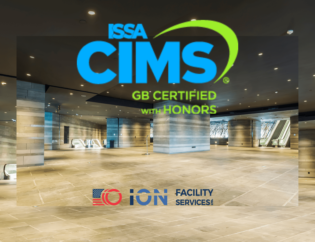
Indoor air quality (IAQ) is certainly not a new priority for facility managers.
Since the pandemic, it has become a more widely discussed topic by occupants and managers across the globe. The main concern, naturally, is that poor air quality has adverse effects on the health of occupants and the overall efficiency of building operations.
Prioritizing IAQ results in a reduction of allergens, pathogens and airborne contaminants – and improves ventilation. There are several ways to enhance indoor air quality for all types of facilities, while exceeding ASHRAE standards and guidelines. Here are six successful ways to achieve this:
Proper ventilation:
Ventilation helps to remove pollutants, allergens, and humidity from the air. Air ducts should be inspected and cleaned regularly to avoid the buildup of dust and other contaminants, and opening windows or using mechanical ventilation systems will bring in fresh air while expelling stale air. As we learned from Covid-19, poor indoor air quality is a health risk to all occupants.
Use air purifiers:
Air purifiers are an effective way to reduce airborne allergens and pollutants in indoor spaces. These devices work by filtering out small particles that can cause respiratory problems, such as dust, pet dander, and pollen. They can also help to remove odors from the air in your facility.
Managers or building owners can also consider the use of portable air purifiers for individual rooms or areas, while larger units can be installed in HVAC systems to purify air throughout the facility.
Proper cleaning:
Regular cleaning is essential to maintaining good indoor air quality. Dust and dirt accumulate over time and become a source of pollutants. Regular janitorial services for floors, carpets, and upholstery can help to minimize dust and other contaminants.
Vacuum cleaners with HEPA filters can prevent contaminants being released into the air. It is also important to use eco-conscious, green cleaning products that do not emit harmful chemicals into the air.
Maintain humidity levels:
Mold and mildew grow quickly with high humidity levels, which can cause respiratory problems. Alternately, low humidity levels can cause dry skin and irritate nasal passages. Maintaining the proper humidity levels throughout your building can help to prevent these problems.
A humidity meter is recommended, and a humidifier or dehumidifier can be used to adjust the levels as needed.
Regular HVAC maintenance:
Scheduled maintenance of HVAC systems, including filter replacement, installing HEPA filtration systems, cleaning coils, and inspecting ducts, can help improve indoor air quality.
Further, committing to regular equipment inspections will ensure proper operations at all times and help predict when replacements may be needed to avoid unnecessary system failures.
Use technology :
Sensors on HVAC systems, thermometers and other related equipment will improve efficiency and operations. These sensors allow technicians to monitor and access HVAC system status in real time, allowing them to make maintenance decisions immediately.
Additional technological improvements include installing ultraviolet-C (UV-C) fixtures on HVAC systems. These fixtures improve heat exchange efficiency while UV-C light disinfects air as it cycles through return air ducts.
At IONFS, we understand that maintaining good indoor air quality is an important workplace safety concern.
It is essential for the health and well-being of occupants and the overall efficiency of operations in facilities.
By implementing the above measures, facilities can significantly improve their indoor air quality, resulting in a healthier and more comfortable environment for employees, guests, patients, customers and visitors.
At IONFSM, we have the experience, products, equipment and highly trained teams who make facility cleaning and maintenance a breeze. Call on us to find a tailored plan that suits your budget and needs.





